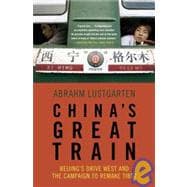
Note: Supplemental materials are not guaranteed with Rental or Used book purchases.
Purchase Benefits
What is included with this book?
Abrahm Lustgarten is a reporter for ProPublica, the not-for-profit newsroom launched in 2008, and the recipient of a MacArthur Foundation grant for international reporting. A former contributing writer for Fortune magazine, his articles have also appeared in Esquire, The New York Times, Outside, Sports Illustrated, National Geographic Adventure, Salon, and many other publications. He lives in New York City.
| A Fifty-Year Ambition | |
| Now Is the Time | p. 3 |
| A Sometime Buddhist | p. 25 |
| A Bigger Stage | p. 47 |
| Stray Dogs | p. 70 |
| Go West | |
| Moving Heaven and Earth | p. 99 |
| Free Tibet | p. 116 |
| Under a Han Sun | p. 143 |
| The Gambler | p. 160 |
| Treasure House | |
| The Race to Reach Lhasa | p. 185 |
| Paradise Rebuilt | p. 205 |
| When the Wang Family Came to Town | p. 229 |
| Hu's West | p. 252 |
| Epilogue | p. 274 |
| Notes | p. 279 |
| Bibliography | p. 289 |
| Acknowledgments | p. 294 |
| Index | p. 297 |
| Table of Contents provided by Ingram. All Rights Reserved. |
The New copy of this book will include any supplemental materials advertised. Please check the title of the book to determine if it should include any access cards, study guides, lab manuals, CDs, etc.
The Used, Rental and eBook copies of this book are not guaranteed to include any supplemental materials. Typically, only the book itself is included. This is true even if the title states it includes any access cards, study guides, lab manuals, CDs, etc.